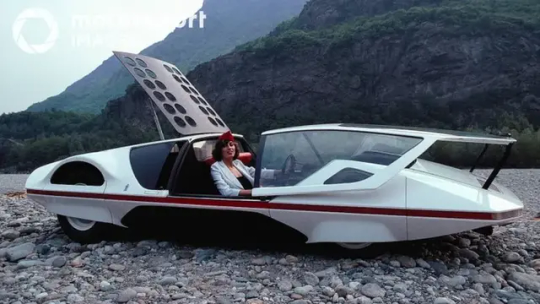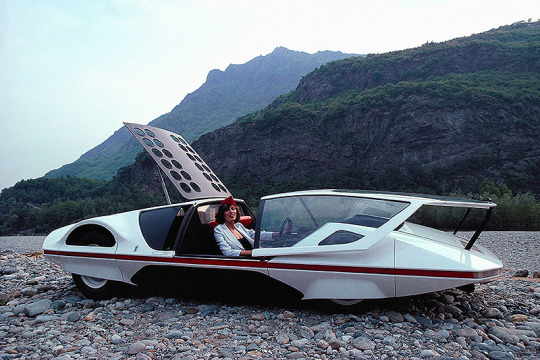#Ferrari 512 S Modulo
Explore tagged Tumblr posts
Text







1970 Pininfarina Ferrari 512S Modulo
My tumblr-blogs:
www.tumblr.com/germancarssince1946 & www.tumblr.com/frenchcarssince1946 & www.tumblr.com/englishcarssince1946 & www.tumblr.com/italiancarssince1946 & www.tumblr.com/japanesecarssince1947 & www.tumblr.com/uscarssince1935
48 notes
·
View notes
Text

Ferrari 512 S Modulo 1970. - source Amazing Classic Cars.
141 notes
·
View notes
Text





1970 Ferrari 512 S Pininfarina Modulo Concept
At the 1970 Geneva Motor Show, Ferrari and Pininfarina stunned the world with the Ferrari 512 S Modulo. Designed by Paolo Martin, this concept sports car showcases a revolutionary wedge-shaped body and a canopy-style glass roof that slides forward for entry.
This 550-horsepower Ferrari V12 can reach a top speed of around 354 km/h (220 mph).
Credits go to @royale77
#concept car#concept#ferrari#pininfarina#modulo#concept cars#future#classic car#classic cars#sports cars#racing#cars#sports car
23 notes
·
View notes
Text
The Bertone styling house is probably the most influential in creating what a 'supercar' looks like. The late '60s and early '70s was the golden era of the wedge-shaped one-of-one concept car and one of the pinnacles of the paradigm, in my view, is this: Marcello Gandini's space-age concept, the Lancia Stratos HF Zero, named to evoke the edge of the stratosphere, the border of space.

This is the very extreme of car design, way beyond utility and into art. When it was first shown, this car was a metalflake copper orange, and was intended to appear carved from a single block of bronze (note the lack of panel seams visible anywhere) but was later resprayed silver. This car is, it must be acknowledged, ludicrous; it's actually hard to fully take in without comparing it to known things like people or other cars because its form is so different. Here are some charming period shots of the car alongside a Lockheed F-104 Starfighter and an apparent cowgirl aviator who's just finished her bombing run and is keen to get home in her Stratos Zero:




The Ford GT40 is so named because it's only 40 inches tall, a fact that clearly made a big impression for that to be the origin of it's name; the Stratos Zero is 33.3 inches tall, due to the remit given to Gandini being to make the lowest possible car, and the occupants (there is a passenger seat) essentially lie down to drive, like luge riders, sliding into the oncoming world feet first.

The windscreen is the door and hinges open at the top like a glazed trapdoor, allowing the steering column to hinge forward on hydraulics. You step inside and duck under the roof sill as you recline on the chocolate bar-like seats. The black panels to the rear of the front wheels are the side windows, allowing you to see the ankles of pedestrians and wheel nuts of other traffic in perfect detail, along with the wing mirrors housed inside the front wheel arches.


While cars like this would become the main application of the pop-up headlight, this doesn't have them. Instead there are ten small lights across the slot on the front, and the rear lights house 80+ tiny red bulbs (well before the advent of LEDs, after all). The car is in fact the first use of sequential indicators, opting to animate the front and rear lights instead of using anything as vulgar as orange indictor lights.

Few concepts before this were this extreme yet functional. Bertone showed the Alfa Romeo Carabo in 1968, and the month before this was shown, Pininfarina displayed the almost equally spacecraft-like Ferrari 512 S Modulo. This car is built from the crashed remains of a Lancia Fulvia Coupé 1.6 HF rally car, the modest (113hp) but rally-tuned 1.6L V4 engine housed beneath the side-hinged triangular louvres, and was constructed without Lancia's knowledge. A couple of months prior to the reveal, Nuccio Bertone came clean to Lancia and asked to put a Lancia badge on what his firm had built. Lancia wanted to see it, so he drove it through Milan, which looked like this:

As I heard it, the gate guard at Lancia was only aware Bertone had arrived when he drove under the barrier, not bothering to sign in. It's the kind of car where these possibly apocryphal stories are made plausible by the implausibility of the car itself; if impossibilities like this could be real, who knows what can happen? In a way the point of one-off concepts like this is to make us dream, push us to imagine better futures where cars like this roam the streets. It certainly pushed Lancia, who observed the buzz around this car and commissioned Bertone to co-build with them a car to replace the Fulvia Coupé that would improve on the Fulvia's already impressive rally record.

That, Bertone did, and even retained the name; a straight line exists between this car and Lancia's legendary status in rallying. The Stratos HF prototype was first shown in 1971, entered production in 1973 and was homologated for rally in 1974, winning the rally chamionship for three years running until internal politics at the FIAT group meant factory support for Lancia rallying was pulled.

The Stratos Zero also caught Lamborghini's eye, and Gandini was hired to design a successor for the Miura. Along with the wedge profile, the early Countach shared the upswept cowling on the rear wheel and the chocolate-bar seats, and the flat, extremely-pitched windscreen, although Gandini reused the scissor doors from the Carabo rather than retaining the hatch-like door/window.

I've been waiting for this model for about 30 years. It appeared in a favourite book of mine in its silver guise, and compared to the copper orange I think it's immeasurably better looking, even if that's its original look. When the recent Hammer Drop series debuted the casting in orange I was disappointed, but luckily I was able to find this silver version from the Marcello Gandini two-pack on its own on ebay for barely over the price of a single car (I already had the red Countach 5000QV from the Jay Leno series, naturally). I understand the Stratos Zero is kind of unpopular compared to other cars in that series, but the only reason I can imagine is that people perhaps understandably don't realise it's not a fantasy car, or at least not entirely. I think it's a stretch to call it fully real either.
#diecast#model cars#hot wheels#bertone#marcello gandini#concept car#lancia#stratos HF zero#the one in Moonwalker was a replica based on a Fiat X-1/9
4 notes
·
View notes
Text
0 notes
Text



Ferrari 512 S Modulo, 1970, by Pininfarina. Designed by Paolo Martin the Modulo was first presented at the Geneva Motor Show in March 1970 finished in black. This picture is from the Turin Motor Show, later the same year, by which time the car has been repainted white.
#Ferrari#Ferrari 512 S Modulo#Ferrari Modulo#1970#Pininfarina#Paolo Martin#concept#design study#retro-futuristic#futuristic#Turin Motor Show#white cars
425 notes
·
View notes
Photo

Ferrari 512 S Modulo (1970)
Image by Anthony Gonner || 500PX
#Anthony Gonner#telkine#ferrari#Ferrari 512 S Modulo#512 S Modulo#classic cats#cars#concepts#concept cars#italian#italy#Paolo Martin
58 notes
·
View notes
Photo

23 notes
·
View notes
Photo

1 note
·
View note
Text


Italian Wedge SilhouetteHistory
Silhouettes of Italian wedge design concept cars from the late '60s and early '70s, including 1969 Autobianchi Runabout, 1970 Lancia Stratos Zero and 1974 Lamborghini Bravo by Bertone, 1969 Fiat-Abarth 2000 Scorpione by Pininfarina, 1968 Alfa Romeo Carabo by Bertone, 1972 Maserati Boomerang by Italdesign and 1970 Ferrari 512 S Modulo by Pininfarina.
This series will available on postcards exclusively for my supporters, who buy me a coffee limited to 50 prints.
Home | Shop | Special Tees | Index | FB | Insta | Newsletter
Buy me a coffee!
#silhouettehistory#ferrari#maserati#alfa romeo#lamborghini#lancia#autobianchi#abarth#fiat#bertone#pininfarina#italdesign#marcello gandini#wedge design#bertone runabout#runabout#lancia stratos zero#stratos#lamborghini bravo#bravo#abarth 2000 scorpione#scorpione#lafa romeo carabo#carabo#maserati boomerang#boomerang#ferrari modulo#modulo#postcard#italiancars
9 notes
·
View notes
Text




+ | Ferrari 512 S Pininfarina Modulo Concept (1970)
#vintage#retro futurism#aesthetic#nostalgia#1970#1970s ad#70s#culture classics#vintage cars#retro aesthetic#ferrarri#modulo#concept design#ferrari 512 tr#vintage culture#classics
11 notes
·
View notes
Photo



Ferrari 512 S Modulo concept. - source Moto Vitelloni - Wheels n' wings
88 notes
·
View notes
Photo

1970 Ferrari Pininfarina Concept 512 S Modulo designed by Paolo Martin via RetroFuturism
112 notes
·
View notes
Video
youtube
1970 Ferrari 512 S Pininfarina Modulo with 5.0 V12 at Villa d'Este 2019
6 notes
·
View notes
Photo

1970 Ferrari Pininfarina Concept 512 S Modulo designed by Paolo Martin
19 notes
·
View notes
Text








Ferrari 512 S Modulo, 1970, by Pininfarina. The car started out as a Ferrari 512S (chassis and engine #27) and was converted to 612 Can Am spec. After testing, the engine and transmission were removed and the chassis was stripped down and given to Pininfarina to build a show car. Designed by Paula Martin, when the Modulo was first presented at the Geneva Motor Show it was finished in black. The canopy glass roof that slides forward to allow entry to the cabin. It was subsequently repainted white to be displayed at the Turin Motor Show and then at the Osaka World Fair. In 2014, Pininfarina sold the Modulo to American entrepreneur James Glickenhaus who has had the car restored but has had the car finished in white.
#Ferrari#Ferrari 512 S Modulo#Ferrari Modulo#1970#mid-engine#V12#Paulo Martin#Pininfarina#Geneva Motor Show#concept#design study#prototype#retro futuristic#futuristic#canopy
759 notes
·
View notes